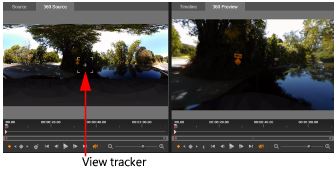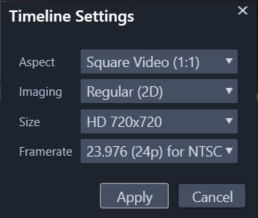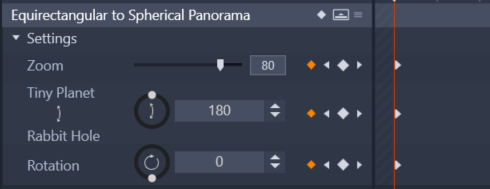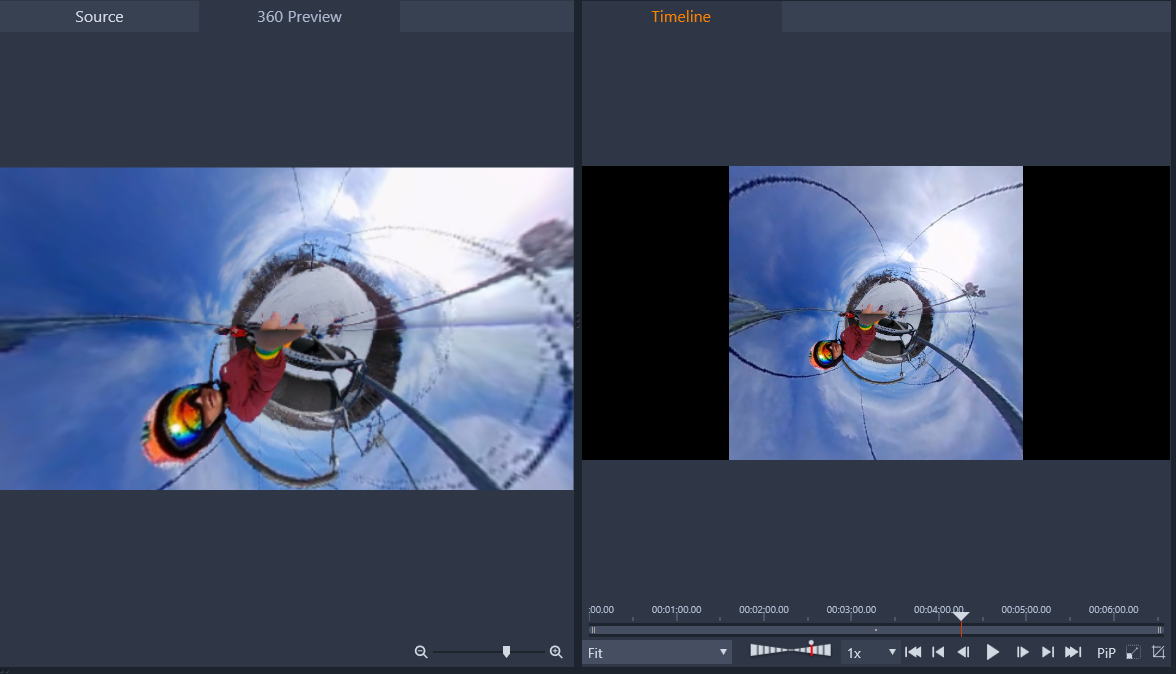360 Video
360 video is an interactive type of video that lets the viewer look in any direction by changing the viewing angle during playback. The viewing angle can be controlled by using a touchscreen, onscreen controls, or by moving the viewing device, such as a smartphone or tablet, in different directions. 360 video requires a special 360 video player (for example, YouTube and Facebook have 360 video players).
Editing 360 video
Pinnacle Studio lets you edit equirectangular, single fisheye, and dual fisheye 360 video footage (check the instructions for your 360 video camera for more information). For example, you can trim the video or add titles or objects. Please note that not all effects can be applied to 360 videos. You can also convert fisheye to equirectangular.
Converting 360 video to standard video
You can also convert 360 video to standard video in Pinnacle Studio. As you play the 360 video, you can set the viewing angle for your audience, similar in effect to a person turning their head to look in different directions. You can then export the edited video as a standard file—no special player is required for the video (not interactive).

When converting a 360 video source to a standard video, the dual preview window makes it easy to select and adjust the view by adjusting the View Tracker.
Tiny planet and rabbit hole video effects
You can use the Equirectangular to Spherical Panorama effect to create tiny planet-style videos, rabbit hole-style videos, or anything in between.
If you have a fisheye or dual-fisheye 360 video, you can convert the file to equirectangular and export the 360 file. You can then apply the Equirectangular to Spherical Panorama effect.
When you apply the effect, the video is converted to a standard format, with a square aspect ratio.

You can confirm the settings for your spherical panorama video by clicking the Timeline Settings button  .
.
 .
.You can use keyframes to adjust the panorama effect as the video plays.
1 In the Edit workspace, drag a 360 video from the Library to the Timeline.
If you want to convert fisheye 360 to equirectangular, right-click the clip in the Timeline, choose 360 Video, and click Single Fisheye to Equirectangular or Double Fisheye to Equirectangular.
2 In the Timeline, click the Timeline Settings button  , and set the following:
, and set the following:
 , and set the following:
, and set the following:• Aspect — choose 360 Video (2:1)
• Size — for best results, choose the highest resolution possible
3 Edit the video in Pinnacle Studio. For example, you can do the following:
• Trim the video
• Add a title or object
• Create a freeze frame effect (Time Freeze)
Note: When you apply a title or object to a 360 video, right-click the item in the Timeline, and choose 360 Video > Insert as 360 to convert the media to 360.
4 When you are finished editing, save your file and click Export.
5 From the Export tab, ensure that the Same as Timeline check box is marked (check mark appears) in the Settings area.
6 Click Start Export.
1 In the Edit workspace, drag an imported 360 video from the Library to the Timeline.
2 In the Timeline, right-click the video, choose 360 Video, and click one of the following:
• Equirectangular to Standard
• Single Fisheye to Standard
• Double Fisheye to Standard
A duel preview mode opens with the 360 Source video on the left and the 360 Preview on the right.
3 In the 360 Source pane, adjust the View Tracker to select a direction. The 360 Preview pane updates to display the view.
The View Tracker appears onscreen as a red square-shaped marker with a crosshair at the center.
4 Click Play to start the video playback. At any time, you can adjust the angle of the view by dragging the View Tracker to a new position.
Keyframes are added when you adjust the View Tracker. You can fine-tune the keyframes with the controls below the preview pane.

Keyframes appear below the preview panes just below the scrubber. Keyframe controls let you go to the previous keyframe, delete a keyframe, go to the next keyframe, and adjust the settings for the transition between keyframes
5 Make any additional edits to the video project, and save.
6 Click Export, and choose the settings you want in the Studio Exporter, and click Start Export.
1 In the Timeline, right-click a 360 video that is in the equirectangular format, and from the context menu choose 360 Video > 360 Video Conversion > Equirectangular to Spherical Panorama.
The Editor panel opens with the Equirectangular to Spherical Panorama controls.

2 In the Player pane, display the Timeline view, and scrub to a scene that you can use as a starting point.

If you will be using keyframes, you can add them in the Editor panel. For more information, see Using keyframes.
3 In the Editor panel, drag the Zoom slider to set the field of view.
4 Adjust the Tiny Planet/Rabbit Hole dial or type a value in the corresponding box.
• Tiny Planet: A value of 180 creates a sphere using the bottom edge of the video as the center.
• Rabbit Hole: A value of 360 creates a sphere using the top edge of the video as the center.
You can experiment and set values between 0-360 and use keyframes to control the transition.
5 Adjust the Rotation dial or type a value to rotate the video to the position you want.
6 Play your video, using the Timeline view to evaluate your settings. Make any adjustments to the settings or to your keyframes.
Note: To reset all controls, from the Select preset menu, choose Default.